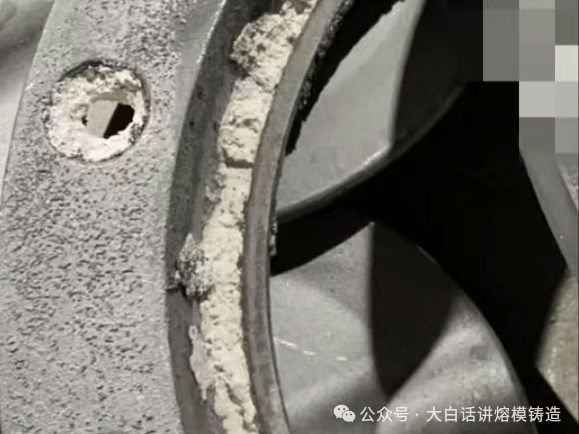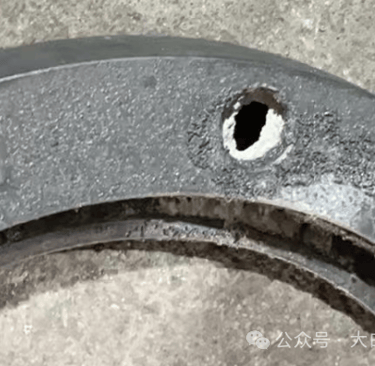Surface Roughness: Sand Burning or Cucumber Spines?
Blog post description.
heweifeng
11/4/20254 min read


Surface Roughness: Sand Burning or Cucumber Spines? (Part 2)
What exactly is the defect on this product – sand burning or cucumber spines? In reality, the causes of these two defects are quite different.
The former, sand burning, is primarily caused by the insufficient refractoriness of the face coat, high pouring temperatures, and high mold firing temperatures. This ultimately leads to a chemical reaction between the molten metal and the face coat material, resulting in sand burning. Generally, the sand burning that occurs in investment casting is most likely chemical sand burning.
The latter, cucumber spines, is directly caused by various shaped holes or cavities on the mold shell surface, resembling "wormholes" or "ant holes". During pouring, molten metal penetrates into these cavities.
In the images provided, we identified defects resembling sand burning, as well as others similar to cucumber spines. During discussions, the team essentially focused on these two defect types. My own assessment is that the defects on this product essentially consist of both: there is sand burning, and there are also cucumber spines. Below, I will explain my reasoning.
First, the defect at the hole location in Figure 1 is most likely sand burning. Judging from its appearance, the local defect looks as if the metal melted and fused with the sand. However, upon further consideration, another possibility is that molten steel leaking from the hole pooled around its periphery. This possibility cannot be ruled out, as the photo of the hole shows traces of metal leakage inside it.
The second picture shows a combination of cucumber spines and sand burning. I conclude the presence of both for two main reasons:
Although based on the defect's appearance it shares characteristics with Figure 1 – featuring densely clustered metal-coated sand areas – it also shows isolated, spot-like defects. This aligns with the characteristic features of both sand burning and cucumber spines.
In Figure 3, the surface of the face coat shell shows distinct holes, which is the reason for identifying the presence of cucumber spines among the defects.
Actually, whether it's cucumber spines or sand burning, a common underlying cause is an inadequate face coat. In Figure 3, we see holes on the mold shell surface. These holes could result from coarse face coat sand, the presence of coarse sand particles mixed into the face coat, or potentially because the face coat slurry film was too thin.
A face coat that is too thin can generally be attributed to two main reasons: firstly, a low binder-to-powder ratio in the face coat slurry itself, and secondly, issues related to the application process leading to a thin slurry film. We often observe that operators, during slurry drainage, hold the part for too long without a proper return motion, resulting in an excessively thin face coat layer.
In this specific case, the binder-to-powder ratio of the slurry was 4:1, with a viscosity of 45 seconds measured using a No.4 cup. Reportedly, this viscosity and ratio are not ideal for achieving a good surface on a part like this. Furthermore, this product has its own particularities – it's a large plate, mounted vertically on a tree in groups of two. Due to its size, slight carelessness during operation can easily lead to localized thinning of the face coat slurry film. Therefore, in principle, I agree with some colleagues who suggested this is primarily an operational issue.
Next, I will focus on discussing several causes of sand burning defects and rank them, hoping this will assist in diagnosing such issues.
The primary cause of sand burning defects is the insufficient refractoriness of the face coat refractory material, excessive impurities, or the use of incorrect face coat sand. Any of these factors can lead to sand burning on the casting.
Low binder-to-powder ratio in the face coat slurry or a thin slurry film after drainage. This situation is akin to cutting corners, effectively reducing the refractoriness of the face coat refractory material.
Relative thickness of the casting wall, casting design leading to localized heat concentration, or improper gating system design causing localized overheating and slow heat dissipation. Under these conditions, refractory materials that normally perform adequately might fail. Therefore, it's important to carefully consider the grade of refractory materials. For instance, zircon sand has classifications like ceramic grade and standard grade (based mainly on two indicators: zirconium silicate content and impurity content). The standards in China typically specify the standard grade, and the quality available on the market can vary. Sometimes a double face coat is used precisely to enhance the high-temperature resistance of the surface layer.
Excessively high pouring temperature or mold shell temperature can also lead to sand burning defects.
In reality, a single defect in a casting is often not caused by just one factor, but is highly likely the result of multiple factors acting together. Among these, one factor is usually dominant, while the others are contributing. Typically, by identifying and addressing the dominant factor, we can largely resolve the problem.




